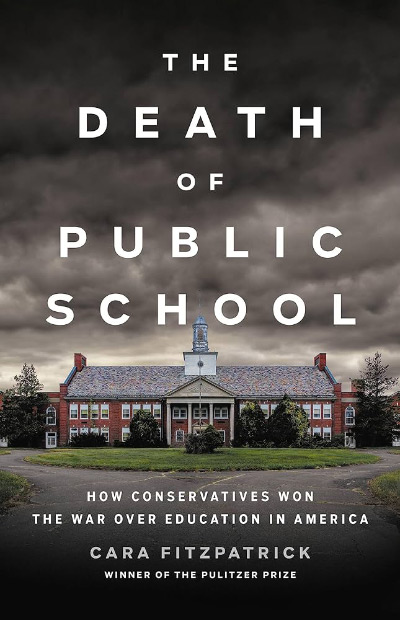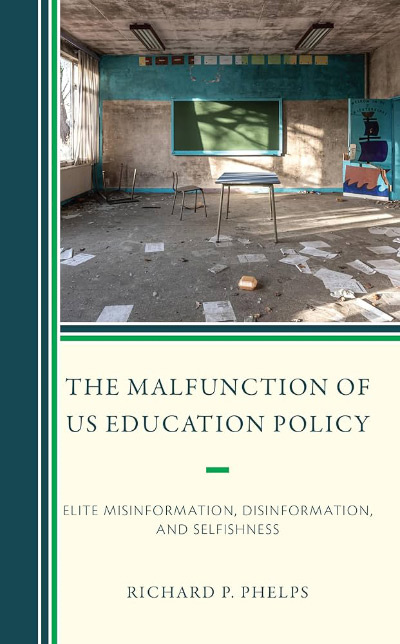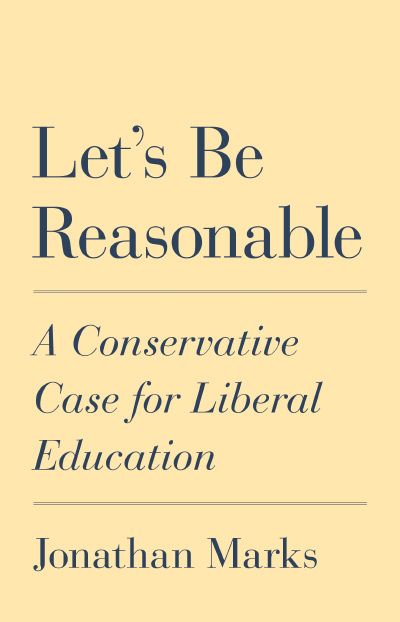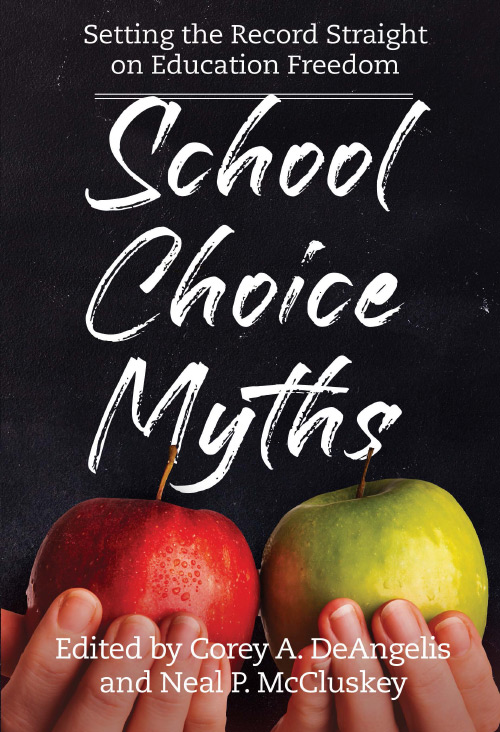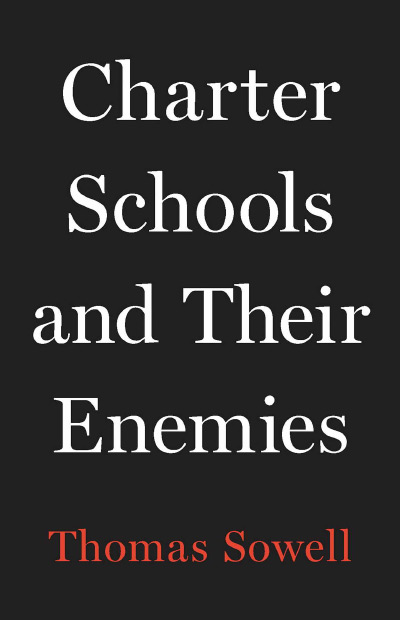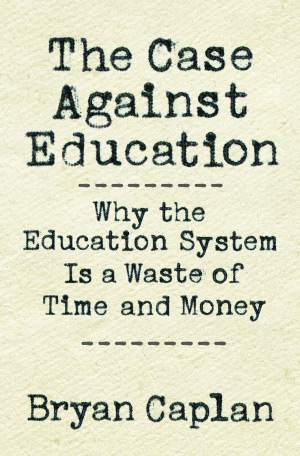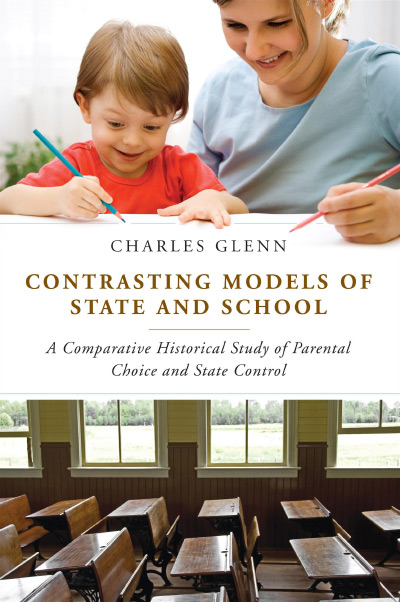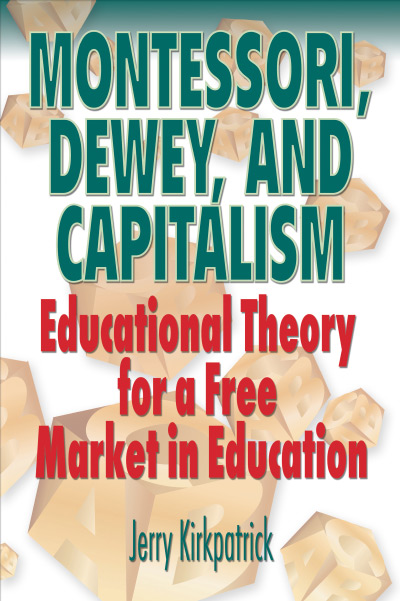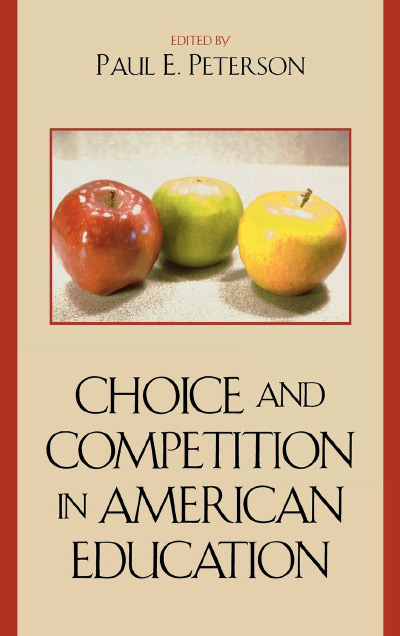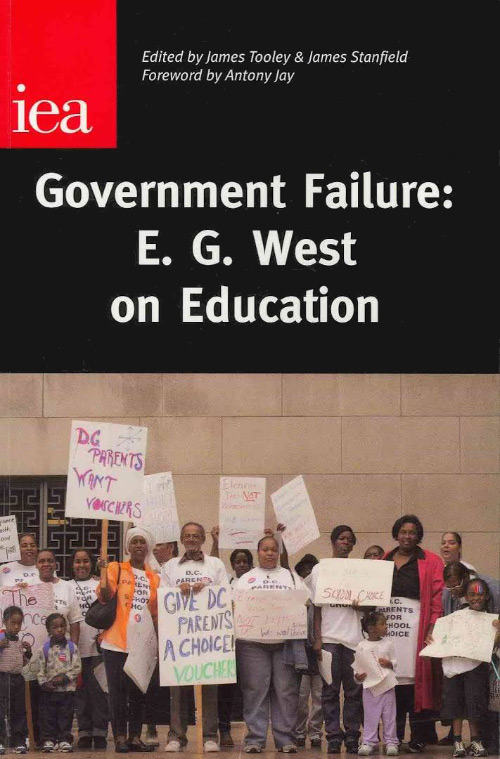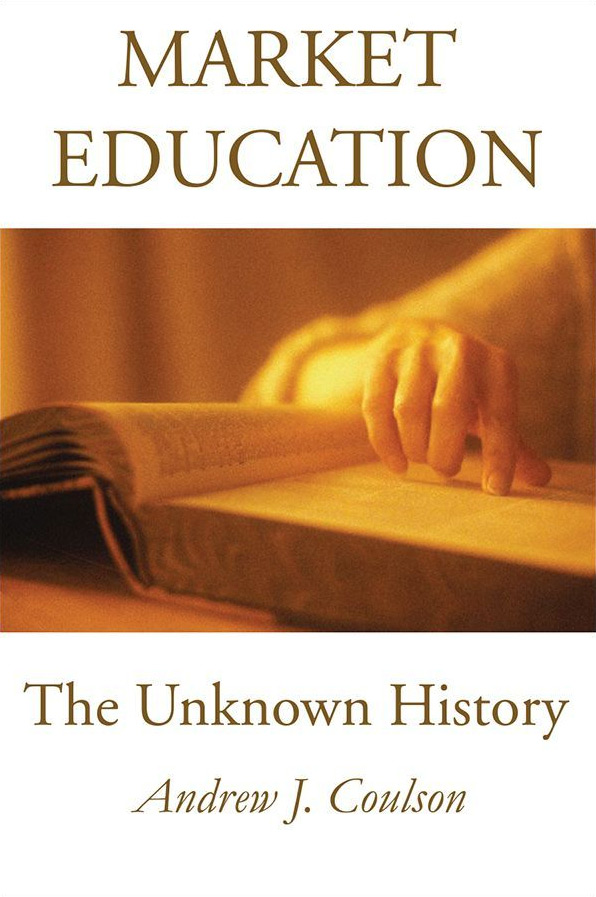The book’s title and subtitle are false claims. Conservative efforts to achieve school systems that provide good-fit, productive schooling for all are still very far from realized, and most states still pursue public education through a public school absolute or virtual monopoly on public funding.
My review copy of the book arrived with reviewer blurbs that are as shocking as the book itself. Those blurbs and the book idealize a terribly costly, predictably “Nation-at-Risk” low-performing process that had better not stay the “nation’s best attempt to educate all of its children” (p. 6). All fifty-one U.S. school systems fall far short of educating all of our children.
The public school system is a process for deciding through often conflicting, confusing federal, state, and local politics what will be taught, how, where, and to whom. Because one size cannot fit all, the process leaves a lot of children behind. Many, many students do not succeed, which yielded Senator Joe Lieberman’s (D, I-CT) prescient conclusion that we “sacrifice ... [a lot of] children for the sake of a process.”
Politicization of what is taught produced curriculum and textbook selection processes that would make the foreman of a sausage factory blush, yielding well-documented condemnation ranging from Chester Finn and Diane Ravitch’s (2004) The Mad, Mad World of Textbook Adoption to Ravitch’s (2003) Language Police and (2000) Left Back, Neal McCluskey’s (2007) Why We Fight and (2022) Fractured Schoolhouse, and Stephen Arons’ (1997) Short Route to Chaos and (1982) Compelling Belief.
Politics produced teaching circumstances (the how) that make imparting important knowledge as hard as it can be made without having that difficulty as an official goal. As reams of data ignored by Fitzpatrick attest, the public school system process yields awful results; not nearly limited to the poor outcomes of the supposedly underfunded, isolated inner-city schools serving the poor acknowledged by Kirkpatrick. The awful results of all fifty-one U.S. school systems include utter failure to realize the common school ideals that drove the establishment of the process. That process “is a Gold-plated disaster” (Governor Gray Davis (D-CA). The critical details are in my (2019, 2022 update) School System Reform.
Fitzpatrick notes in the opening pages that there are efforts to redefine “public education,” but she repeatedly asserts that “public education” and “public school system” are synonyms. The leftist spin on policies that aim to level the playing field between schooling options—“public dollars to pay for private school” (p. 48)—something deemed “most extreme” (p. 140) appears repeatedly. And “far right” (p. 116) appears a few times. “Far left” does not appear at all. But it is far left to note the irrelevant fact that Thomas Jefferson had slaves in a discussion of possible definitions of public education. And it is far left to assert, without evidence, that public funding following children to a better-fit charter school or private school choice is bad because it “drains” or “bleeds” (p. 224–225) money from the public school system. An unbiased fact is that “public dollars to pay for private school” reduces the public funding discrimination against the children for whom the assigned traditional public school (TPS) is a poor fit, which helps TPS leavers and stayers.
She bemoans any efforts to rescue children from TPS officially designated as “failed” or to reform “Nation at Risk” systems, or to allow easier escape from poor-fit situations that exist at every TPS because one-size can never fit all.
The unanticipated, but now obvious housing market dynamics of flight from “Nation-at-Risk” low-performing traditional public schools concentrates poverty around the worst TPS (the terrible where and to whom effects of the public school system process), which yields de facto segregation that makes the lowest performing schools even worse. Sure, “segregated schools are the natural result of housing patterns” (p. 112); housing patterns that designation of TPS attendance areas are largely responsible for. Ask any realtor, and see Tim DeRoche’s (2020) A Fine Line.
She lauds the intent of the assigned neighborhood common school model, despite that model’s well-documented (mostly ignored by her) failure to live up to those ideals. She correctly condemns the despicable intent—sustain segregation—of initial efforts to lower the cost of alternatives to TPS, despite the often-praiseworthy outcomes of those laws noted by Milton Friedman. Non-segregationists “used them [tuition vouchers] in unexpected ways” (p. 56); “using them to attend integrated private schools” (p. 57)” Had those laws been retained, but with the now widespread bans on racial and ethnic bias to prevent the realization of despicable intent, we might have avoided our further deteriorating “Nation at Risk” status and be in a situation where Fitzpatrick’s subtitle could be seen as credible.
Fitzpatrick makes passing mention of the 1983 best-known version of the “Nation at Risk” alarm (a National Commission report), but makes no mention of other alarm bells such as: a) the Sputnik scare blamed on poor school system performance that led to frenzied, but ineffective attempts at TPS improvement; b) Rudolph Flesch’s (1955) Why Johnny Can’t Read; c) Admiral Hyman Rickover’s low educational attainment-driven national security concerns in (1959) Education and Freedom; d) Joel Turtel’s (2005) Public Schools: Public Menace; and e) another five Nation-at-Risk declarations after 1983. Fitzpatrick also fails to mention horrifically bad test score data that still indicates that even the top-performing states, which are not the top-spending states, have huge percentages of school-age children below the basic skills level; much worse than not proficient.
I had to use the pejorative “fails to mention” because Fitzpatrick is not lazy. While digging up a lot of detailed history, she must have encountered the repeated “Nation at Risk”-equivalent books and reports, many of them, non-partisan or bipartisan, and recurrent, awful “Nation’s Report Card” scores from the National Assessment of Educational Progress.
If you can resist absorbing the leftist selectivity and slant imparted by Fitzpatrick, you will learn a lot of interesting history from her deep dives into various archives. She points out the little-known fact that the intent underlying the first school-choice expansions was to avoid integration alongside claims that public school systems are essential for democracy but didn’t recognize (or acknowledge) that democracy produced the very persistent resistance to integration. The least democratic element of government, the courts, overcame that resistance. Because many private schools offered pedagogical diversity, some of the school-choice expansions motivated by that resistance yielded some integration despite the housing patterns supported by affluent family relocation to the attendance areas of the best TPS.
She does not report that all of the school-choice expansions raised traditional public school per-pupil funding and did not cite the considerable evidence that high levels of per-pupil funding have: a) failed to yield noteworthy TPS improvement; and b) not made the politically-correct comprehensive TPS fit all or, even better, fit a significant number. For example, a lawsuit provided Kansas City schools phenomenal funding levels that failed to significantly improve performance.
Fitzpatrick mentions the struggling D.C. system, that despite per-pupil funding at $24,535/pupil (a number I easily found but missing from Fitzpatrick’s book)—second only to New York, nearly twice the still very hefty national average (not reported)—still produces terrible results. The widespread lamentations of underfunding of TPS, including by Fitzpatrick, never (I’m not aware of any exceptions) note the existing, arguably large, and mostly rising funding levels.
Fitzpatrick asserts that the small, often tiny, narrowly targeted private school-choice expansions (almost nothing until 2022) that are the focus of the book amounted to giving up on traditional public schools (p. 150, 196). Ridiculous! Even the universal programs enacted in 2022 and 2023—not discussed in Fitzpatrick’s book—only amount to giving up on TPS’ ability to acceptably fit all.
She ignores key restrictions of the Milwaukee Voucher program, which she discusses extensively. Paul Peterson, Jay Greene, and Chad Noyes (1996, School Choice in Milwaukee, ThePublic Interest, Fall: 38–56) argued that the restrictions created a designed-to-fail situation. Yet, Fitzpatrick and others, use a very broad brush in utilizing disappointing Milwaukee results (not all were) to condemn choice expansion generally.
An objective analyst would have included failure evidence in failure discussions (p 130–131) and also followed the Robert Chanin (lead lawyer opposing school-choice expansions) quote—“The message [of resistance to choice expansion] is improve the public schools” (p. 214)—with the disappointing general and specific evidence regarding improvement efforts. And there is nothing about school-choice expansions limited to a few thousand children that increased TPS per-pupil funding that support Fitzpatrick’s inference that such programs undermine effort to “remedy failing schools” (p. 231). Giving up on one-size-fits-all via TPS by adopting universal school-choice expansion is a key part of the remedy.
The book’s title and subtitle are wrong, because: a) conservative efforts to realize productive, transformational (2019, 2022 book) School System Reform are still not nearly realized (more below); and b) the public school system process is not dead, it is unlikely to die, and it need not die for us to have the desperately needed, much higher functioning U.S. school systems. In my definition of the public education commitment, school systems are all schools, public and private. Many TPS work well for many of the children assigned to them. And TPS will work even better when we end the public funding discrimination against the children for whom the assigned TPS is a poor fit. Because one size cannot fit all, “public funds only for public schools” (p. 229)—a demand of school-choice expansion opponents—is public funding discrimination that makes school systems, including TPS, less effective. Providing easy access to TPS alternatives for the children for whom the assigned TPS is a poor fit will reduce the differentiated instruction challenge of TPS teachers to a level manageable by average teachers. That huge, virtuous effect happens when the assigned TPS poor-fits can find a better fit in another school, TPS, charter, or private.
That people such as Fitzpatrick can get people to care deeply whether a governmental entity or a private entity delivers instruction is a testament to the terrible civics instruction and economic illiteracy produced by the politicized content of TPS and teacher training. There is widespread failure to recognize the severe limits of political accountability processes. That every aspect of the public school system is a political choice—a result of a special interest-dominated, inherently messy and nasty process (too extensive for citizens to effectively monitor: see Myron Lieberman’s [1993] Public Education: An Autopsy)—is what produced the fifty-one Nation-at-Risk-bad U.S. school systems.
Unrealistic fear of free enterprise-driven activity (Herbert Walberg and Joseph Bast [2003], Education and Capitalism: How Overcoming Our Fear of Markets and Economics Can Improve America’s Schools) results from failure to discern the huge differences between truly evil crony capitalism (rigged through political influence) and impersonal, wide-open capitalism (See William Baumol, Robert Litan, and Carl Schramm’s (2007) Good Capitalism, Bad Capitalism) that yields enormous widespread prosperity even with the underlying motive of self-interest that sometimes amounts to greed.
Contrary to the subtitle, conservatives have not nearly secured the critical end to the public funding discrimination against the children for whom the assigned traditional public school is a poor fit. That’s true even with the recent important school-choice expansions absent from Fitzpatrick’s book (maybe because her final draft pre-dated those reforms). She asserts that sixty, mostly tiny, narrowly targeted school-choice expansions, limited to twenty-six states, are proof that school choice had spread like wildfire—Milton Friedman’s prediction. Hardly!! Certainly not yet. In most states, escape from an assigned TPS is beyond the means of nearly everyone. In all but a few states, escaping the current assigned TPS still requires a) payment of private tuition and the taxes that fund TPS—a widely unaffordable combination; or b) relocation to a different attendance area. That relocation escape hatch from low-performing TPS is only available to families that can afford the higher housing costs near a better TPS (Tim DeRoche’s (2020) A Fine Line). The fact that only the more affluent families can afford those higher costs means that the public school system process has the devastating effect—a segregating effect—of concentrating the poorest families in the attendance areas of the worst TPS.
That even well-informed, well-meaning people don’t recognize their own bias is a foundational principle of my nascent Institute for Objective Policy Assessment (policytalk.org). Part of the IOPA assessment process is civil, informed disagreement, where Fitzpatrick would be most welcome and very useful. I want her to explain why shunning the use of public funds to provide children a better-fit, more engaging (= more effective for them) alternative to the assigned TPS, that may be privately owned, justifies trapping children in a TPS that is a poor fit for them.
| Other Independent Review articles by John D. Merrifield | ||
| Winter 2023/24 | The Malfunction of U.S. Education Policy: Elite Misinformation, Disinformation, and Selfishness | |
| Fall 2016 | Swedish and Swiss Fiscal-Rule Outcomes Contain Key Lessons for the United States | |
| Fall 2006 | Choice and Competition in American Education | |
| [View All (5)] | ||



